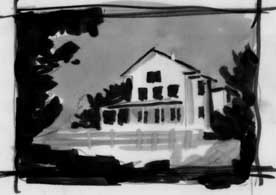|
|
|
| This is what I mean by simple plan of lights and darks. It really helps when you're setting up the painting. | Obviously, there is still a lot of drawing to do after the sketch, but I generally stuck to my plan for this commission, a historic view of a friend's house. |
Exhibiting your work
No time is too soon to enter competitions or exhibit
your work at sales and community art
organizations if you want to. The sooner you get some rejection slips under your belt, the sooner you'll
realize that you will get into some shows and not others, but rejections are not an absolute statement
about
the quality of your work. Above a certain level of competence, the final decision is more
a
reflection of the personal choices of the juror. The more times you enter, the
more times you'll be accepted as well as rejected.
I don't remember who said it, but the quote
was "I always learn what I can from the mistakes of others. I don't have time to make
them all myself."
Here are a few tips, therefore, from my previous mistakes:
GOOD PHOTOS - Remember that you are being judged on your
photos, not your paintings, until you get in the show. It's important that the
photos are properly exposed and focused and represent your work as close as
possible.
ORIGINAL WORK -
Which painting has the most impact from across the room? Which painting shows a new way of looking
at a
common subject or does a good job of depicting an uncommon subject or mood? Is it a good
photo with the right exposure and focus? You must imagine jurors looking at
hundreds of images.
When
yours pops up, you want them to think, "I wish I'd painted that. What a
good idea." And remember -
some paintings just look better in a digital photo than others. You are being juried on
your photo, not your painting. If you can't decide which painting to submit,
pick the best-looking photo. Sometimes it helps to have an artist friend look at
your paintings and give you an opinion.
Your web page
You might want to consider starting a web site for yourself. It's really a good way to get some exposure and it's quite interesting to share your site with other artists on-line. Also, it's a good way for people who have purchased your paintings to see what you're doing now.
I'm not really an expert at this, but creating a web page can be fairly painless. I'm using Microsoft Frontpage now, which comes with an editor and makes it easy to organize and then modify your pages. They have several sample pages that you can start with. There are a lot of other programs, of course, but this one works for me and I know it well enough that I don't have to waste a lot of time editing my site.
I use a digital camera to add images, recently upgrading to a Canon G9, which is capable of 12 Megapixels, much more than you really need for the web or to submit digital entries to exhibitions. It cost a little over $400 and was a good deal for that kind of power. These images can be edited in a photo editing program and sized down. I usually use 72 dpi on the web site, which seems adequate and doesn't use a lot of space or take a lot of time to download when someone is visiting your site.
e-mail price@hancock.net BACK TO MAIN MENU

